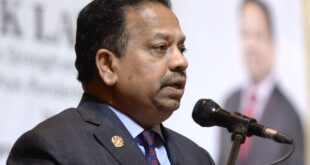IN conjunction with World Ozone Day, Global Environment Centre (GEC) co-organised a communication, educational and public awareness programme called “Plant for Tomorrow” at SMK Gadong, Beaufort.
Some 120 people including students and teachers from SMK Gadong Beaufort, government agencies and community members participated in the effort.
The programme was co-organised and supported by Sabah Forestry Department (SFD), Department of Environment (DOE) Sipitang branch and Komuniti Hutan Gambut Semenanjung Klias (KHGSK).
SFD and DOE representatives held respective sharing sessions with students and local communities on the importance of peatland ecosystem and climate change.
Students planting trees at SmK Gadong beaufo
Beaufort DOE expounded on its monitoring efforts and recycling initiatives while KHGSK described the importance of planting peat swamp tree species to rehabilitate degraded peatland areas.
Students also got hands-on experience on peatland rehabilitation initiatives by planting 14 trees in the school yard.
These initiatives are aimed at exposing students and local communities to the importance of peat ecosystem and its linkage to climate change.
This is because they live in or near peatland landscapes including the 3,630ha Klias Forest Reserve and 12,106ha Binsuluk Forest Reserve.
Beaufort District Forestry officer Christopher A Matunjau, who launched the event, said it was important to involve youths in caring for the environment.
“We need to foster a society who cares about their surroundings, are capable of protecting the environment and are using it sustainably,” he said.
“This way, the future generation will be able to continuously benefit from the environment.”
GEC Peatland Programme manager Serena Lew Siew Yan said, “Undisturbed peatlands in good condition contribute to climate change mitigation by storing tonnes of atmospheric carbon in peat soil, more than other vegetation types combined.
“Conversely, burning peatlands contribute to climate change by releasing carbon into the atmosphere at a high rate, generating smoke haze that can impact humans as well as biodiversity health.
“On that account, a green and effective way to reduce emissions significantly is by protecting healthy peatlands and restoring degraded ones.”
 BeritaKini.biz Berita Viral Terkini di Malaysia
BeritaKini.biz Berita Viral Terkini di Malaysia





